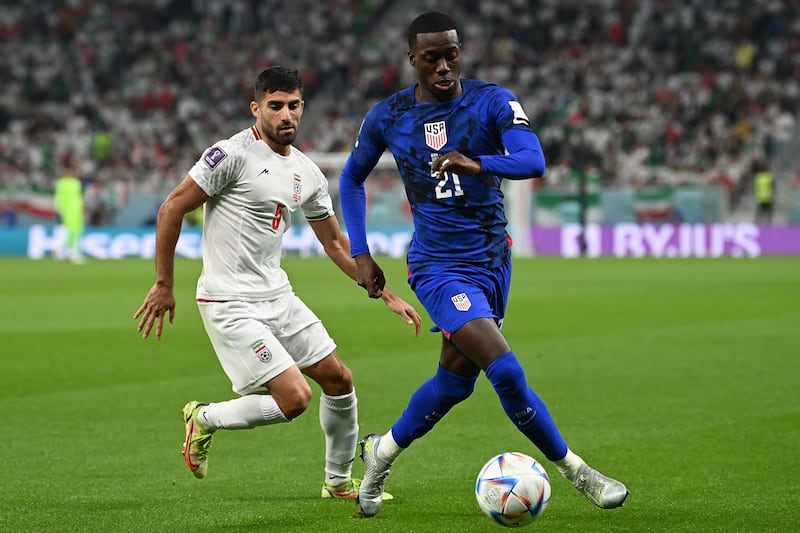It’s nearly half a century since Pele made his New York Cosmos debut on a threadbare Randall’s Island pitch spray-painted green to look more respectable for the television cameras. Very soon after, the club was selling out Giants Stadium in New Jersey and soccer mania swept the nation. Young kids drawn to the beautiful game then are eyeing retirement now and the fringe sport they fell so hard for boasts 12 million participants across the nation. An astonishing number that makes the USA’s performance at the World Cup worthy of a more critical review.
Consider the American XI that started the defeat of Iran last week. Antonee Robinson grew up in Milton Keynes and came through the ranks at Everton. Sergino Dest was born in the Netherlands and developed at the Ajax Academy. Yunus Musah was born in New York but moved to Italy as an infant and eventually started training with Arsenal at the age of nine. Cameron Carter-Vickers is an Essex native who was at Tottenham Hotspur since his 11th birthday. Timothy Weah started life in Queens but moved to Paris full-time at just 14.
Every country exploits the international eligibility rules but what does it say about the production line at home when half the outfield starters in that match honed their skills abroad? Not anything good. There are other curious and disturbing statistics too. Just four of the American squad were Hispanic. A paltry figure put into stark relief by the fact Gregg Berhalter picked more players in his 26 who had attended private high schools than he did individuals with Latino heritage. The coach himself is, of course, an alumnus of the $15,000 a year St Benedict’s Preparatory in New Jersey.
According to the last census, America’s Hispanic population is now north of 60 million. More than half are Mexican and most of those are futbol crazy. Yet, once Berhalter opted to leave out Ricardo Pepi (a 19-year-old striker banging them in for Groningen in Eredivisie), no Mexican American travelled to Qatar. A demographic which plays soccer in huge numbers all over this country yet very few of them seem to make it through the pipeline to the national team. Why? Is it the prohibitive cost of elite sport here or something else?
READ MORE
“There are so many talented kids playing soccer in little cities like Oxnard, but nobody seems to see them,” said David Ochoa, a Californian who declared for Mexico at Under-21 level after feeling unwelcome in American youth squads. “There are more than 35 million people living in the US who were either born in Mexico or have Mexican origins, but hardly any of them are playing soccer professionally here. It’s really weird, right? There should be many more.”
The absence of Mexican Americans is only one oddity. Six of the squad are the sons of former professional players, a couple more had parents who are professional coaches. Basically, one-third of them grew up in the maw of the sport with unique advantages and access unavailable to children whose families are not steeped in the game. Not least of these perks was that lack of money was never an obstacle to them playing. Unfortunately, that remains a hurdle for many in a country where a talented teen with aspirations needs parents splurging $5,000 a year to keep the dream alive.
“It is not the figure,” said Zlatan Ibrahimovic of being asked to pay $7,000 per season for his 11- and 13-year-old sons to join a team in Los Angeles. “It’s the concept. I dislike it very much because not everyone has the money needed and the sport should be something for everyone because it unites people of whatever origin.”

35 per cent of those who play soccer in America are from households with annual income over $100,000. In contrast, less than 10 percent of the playing population come out of homes in the under-$25,000 bracket. One of Berhalter’s resolutely middle-class squad is the son of an orthopaedic surgeon, another is the child of two prominent research scientists. This surely is the only team in the competition on which a player could talk about a childhood that involved private individual soccer lessons from a retired Brazilian international.
The Washington Post recently celebrated how, with 12 black players, this is the most diverse American outfit ever. In some ways it is, but one of that dozen is the son of the president of Liberia, several more were born overseas, and, even Desmond Armstrong, the first African American to represent the USA at a World Cup back in 1990, put that stat in context by pointing out how soccer remains far too exclusive.
“A lot of the diversity on the US team are players who grew up with advantages, from the suburbs,” he said. “It’s a big country with people from every background imaginable, and soccer isn’t fully taking advantage of that. That’s the missing piece of the puzzle.”
In these parts, nobody is interested in hearing any carping right now because the national mood remains optimistic. A young team performed credibly in reaching the second round and talk has already turned to what they might achieve as hosts three and a half years from now, the positive outlook underpinned by so many players plying their trade at serious European clubs.
There are reasons to be cheerful but so many serious questions that are not even being asked.


















